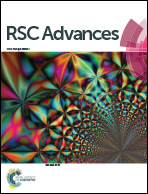Positive effects of concomitant heavy metals and their reduzates on hexavalent chromium removal in microbial fuel cells†
Abstract
Cr(VI) laden wastewaters generally comprise a range of multiple heavy metals such as Au(III) and Cu(II) with great toxicity. In the present study, cooperative cathode modification by biogenic Au nanoparticles (BioAu) reduced from aqueous Au(III) and in situ Cu(II) co-reduction were investigated for the first time to enhance Cr(VI) removal in microbial fuel cells (MFCs). With the co-existence of Cu(II) in the catholyte, the MFC with carbon cloth modified with nanocomposites of multi-walled carbon nanotubes blended with BioAu (BioAu/MWCNT) obtained the highest Cr(VI) removal rate (4.07 ± 0.01 mg L−1 h−1) and power density (309.34 ± 17.65 mW m−2), which were 2.73 and 3.30 times as high as those for the control, respectively. The enhancements were caused by BioAu/MWCNT composites and deposited reduzates of Cu(II) on the cathode surface, which increased the adsorption capacity, electronic conductivity and electrocatalytic activity of the cathode. This study provides an alternative approach for efficiently remediating co-contamination of multiple heavy metals and simultaneous bioenergy recovery.



 Please wait while we load your content...
Please wait while we load your content...